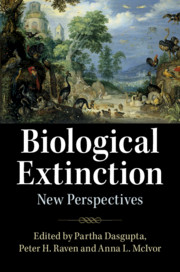Book contents
- Biological Extinction: New Perspectives
- Biological Extinction: New Perspectives
- Copyright page
- Dedication
- Contents
- Figures
- Tables
- Contributors
- Preface
- Acknowledgements
- Introduction
- Prologue
- 1 Extinction in Deep Time
- 2 Biodiversity and Global Change
- 3 The State of the World’s Biodiversity
- 4 Extinction Threats to Life in the Ocean and Opportunities for Their Amelioration
- 5 Out of the Soil
- 6 The Green Revolution and Crop Biodiversity
- 7 Population
- 8 Game Over?
- 9 Why We’re in the Sixth Great Extinction and What It Means to Humanity
- 10 The Consequences of Biodiversity Loss for Human Well-Being
- 11 Terra Incognita
- 12 How Do We Stem Biodiversity Loss?
- 13 Can Smart Villages Help to Stem Biodiversity Loss?
- 14 The New Design Condition
- Index
- Plate Section (PDF Only)
- References
5 - Out of the Soil
Soil (Dark Matter Biodiversity) and Societal ‘Collapses’ from Mesoamerica to Mesopotamia and Beyond
Published online by Cambridge University Press: 19 August 2019
- Biological Extinction: New Perspectives
- Biological Extinction: New Perspectives
- Copyright page
- Dedication
- Contents
- Figures
- Tables
- Contributors
- Preface
- Acknowledgements
- Introduction
- Prologue
- 1 Extinction in Deep Time
- 2 Biodiversity and Global Change
- 3 The State of the World’s Biodiversity
- 4 Extinction Threats to Life in the Ocean and Opportunities for Their Amelioration
- 5 Out of the Soil
- 6 The Green Revolution and Crop Biodiversity
- 7 Population
- 8 Game Over?
- 9 Why We’re in the Sixth Great Extinction and What It Means to Humanity
- 10 The Consequences of Biodiversity Loss for Human Well-Being
- 11 Terra Incognita
- 12 How Do We Stem Biodiversity Loss?
- 13 Can Smart Villages Help to Stem Biodiversity Loss?
- 14 The New Design Condition
- Index
- Plate Section (PDF Only)
- References
Summary
Much of what we can say about the ebbs and flows of ancient societies comes embedded in and directly from the soil. The soil provides evidence about its past and about the qualities it provided for ecological health and human resources. This is important to the topic of this book because the soil, or the pedosphere, is the ultimate domain of ecosystem services and holds the Earth’s highest biodiversity. In this chapter, we begin with a review of biodiversity and erosion in the underappreciated soil ecosystem and then consider societal collapses, extinctions in a sense, mainly through the lenses of geoarchaeology or archaeology using many tools of the geosciences.
- Type
- Chapter
- Information
- Biological ExtinctionNew Perspectives, pp. 138 - 174Publisher: Cambridge University PressPrint publication year: 2019
References
- 6
- Cited by



